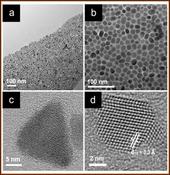Highlight
Novel low-cost Cu(In1-xGax)Se2 (CIGS) nanocrystal-based photovoltaics
Achievement/Results
IGERT Trainee Brian Goodfellow and Graduate Students Vahid Akhavan, and Matt Panthani working under the supervision of IGERT Faculty member Dr. Brian Korgel at the University of Texas – Austin have developed novel low-cost Cu(In1-x¬Gax)Se2 (CIGS) nanocrystal-based photovoltaics and have achieved power conversion efficiencies of greater that 1%.
CIGS is one of the most promising solar-cell absorber materials due to its high absorption coefficient, its energy bandgap—which is optimally matched to the solar spectrum—, and its stability over long periods of time. CIGS-based solar cells have achieved nearly 20% power conversion efficiency in the laboratory. However, conventional fabrication of CIGS solar cells requires high vacuum deposition techniques which is makes them too expensive for widespread use. Additionally, production of conventional CIGS solar cells required high temperature processing steps and thus limits the type of substrate on which they can be fabricated.
We have developed a synthesis for CIGS nanocrystal "inks"that can be solution processed by a variety of techniques including drop-casting, dip-coating, spin-coating, airbrushing, and inkjet printing. Additionally, the specific composition of the nanocrystals can easily be tuned for the desired application. See Figures 1 -3.
Address Goals
These nanocrystal “inks” have been used to make functional photovoltaic devices with efficiencies greater than 1%. Furthermore, the solution processability of these inks has enabled a variety of device architectures not accessible to conventional CIGS devices—including flexible solar cells. See Figures 4-5.
Further work is underway to understand the performance of CIGS nanocrysal-based photovoltaics and to improve device efficiencies further. We hope to achieve efficiencies of 10% in the coming years—making widespread commercialization of this technology possible.










